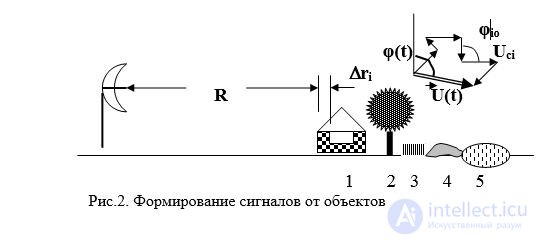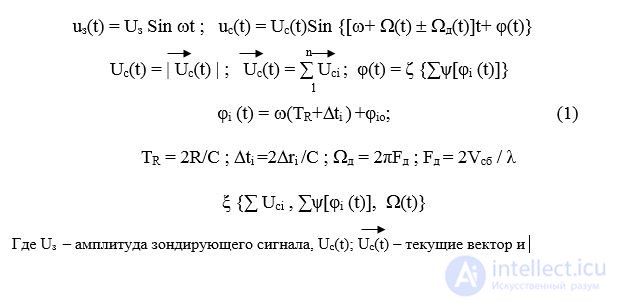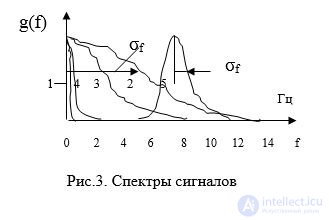Lecture
annotation
The signature of the signals reflected from different objects and environments may differ. The main differences in the spectral composition and amplitude distributions. So, signals from humans and technology differ significantly. From armored and automotive engineering slightly. The most interesting and useful can be the analysis of signals from vegetation in the interests of ecology.
Plan
Formation of signals from objects and plant media.
Specific signs of signals.
The signals reflected from the surface in ground-based radars differ from the signals of the radar-based aviation spectral composition.

Fig.2. Formation of signals from objects
For a radar of continuous monochrome radiation, the probing u з (t) and the signals reflected from the ground object u c (t) can be recorded as follows.

modulus of amplitude of the reflected signal; U ci , U ci - vector and module of the elementary signal reflected from the structural element of an object on the earth's surface or a permitted site; φ (t) is the current phase as a functional ζ of the partial phases of the i - th elements φ i (t); T R , Dt i - time delay of the signal of the reflected signal from the object and its components; F d - Doppler frequency; W d (t)] is a function of frequency modulation.
It is known that a ground object reflects signals by each i - th element of its design. The most significant of them are the so-called "brilliant points". These partial components have their phase φ i (t) and amplitude U ci and, adding vector, form the total signal U c (t).
If the object is stationary (bare terrain, structure), then the total amplitude will be constant, or slowly varying. If the surface object is vegetation, then under the action of the wind the leaves, grass, stems, and tree trunks will move. Then the amplitude-phase structure of the elements, and hence the total signal, will change. These changes are usually stochastic in nature. The statistical characteristics of the total reflected signal will depend on the type and structure of the object, its size, wind speed, etc. Thus, by the statistical characteristics of the signal, one can indirectly judge the class of the object or part of the terrain and its condition. In general, this dependence is defined by the functional ξ {U ci , ∑ψ [φ i (t)], W (t)}.
The number of stochastic characteristics of the signal, by which one can indirectly judge the state of the surface, is the width of the spectrum. Under the direction of the applicant, a team of specialists recorded signals from various parts of the localities. In fig. Figure 3 shows examples of spectra from objects indicated in Fig.2. 1 - brick rural house; 2 - deciduous tree; 3 - grass; 4 - “naked” ground; 5 - water surface.
As can be seen from Figure 3, the width of the spectrum σ f can serve as one of the signs for recognizing the class of an object or a surface. For example, it has been established that a tree not affected by the silkworm with a wind of 5 m / s in the 3 cm range of radio waves has a spectrum width σ f = 6-8 Hz. Affected - only 3-4- Hz.
The annual spectral analysis of signals from the locality can reveal areas where vegetation dies from air pollution by products of industrial activity, where destructive deforestation is carried out, etc.
As an example in Fig.4. modeled the situation of reduction
plant environment in the blast furnace area. At the same time, curves of equal widths of the frequency spectrum (6 Hz) were plotted on the map of the site.

Fig.3. Signal spectra
The overlay of two annual maps immediately revealed a significant reduction in vegetation, which is associated with the technogenic activities of the enterprise
Unfortunately, using only the feature of the spectral width is not enough. Depending on the wind speed in the surface layer, the width of the spectrum can vary significantly. Therefore, it is necessary to search for other informative features, for example, in the areas of the amplitude distribution laws w (u), the nature of the frequency modulation Wd (t), and others. In addition, it is necessary to consider the option of a review of the surface with aircraft carriers. Here a more difficult situation arises with the formation of the spectral composition. The terrain and radar converge. Moreover, the speed of approach, corresponding to the upper and lower edges of the antenna pattern are significantly different. Therefore, the width of the convergence spectrum in real systems is orders of magnitude larger than the widths of the fluctuation spectra, which does not allow recognition of the surface state without special hardware-software measures.
Test questions.
Comments
To leave a comment
Radio Engineering Systems
Terms: Radio Engineering Systems